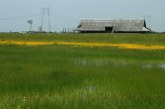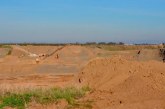Yolo County Releases Draft of Updated General Plan
The last update was in 1983, based on the county’s original General Plan from 1958. In May 2003, the Board of Supervisors gave direction to begin the current General Plan update process. This is only the third time in the county’s history that the General Plan has been comprehensively updated. While the fundamental land use goals of promoting agriculture and directing urban growth to the cities have not changed, circumstances facing the county have changed. Agriculture requires flexibility to allow it to branch out into processing and tourism related businesses. Similarly, several of the county’s small towns require new infrastructure, investment, and services that can accompany well-designed growth. There is also a greater need for economic development to provide growth and stability to the county revenues that pay for local services. This General Plan update allows the county to examine these issues and chart a course for the future that meets these challenges.
Yolo County is 653,549 acres in size, of which 32,325 acres (just under 5%) lies within the four incorporated cities. Currently, approximately 23,265 residents live in 7,263 homes within the remaining 95% of the county, along side 430 acres of job-producing commercial and industrial land. Under the existing 1983 General Plan, another 11,240 residents, 4,014 homes, and 1,440 acres of commercial and industrial land could be added. The Preferred Land Use Alternative, adopted by the Board of Supervisors on September 18, 2007, is the basis for creating the General Plan update. In addition to the 1983 General Plan, it would allow for another 26,600 residents, 9,500 homes, and 901 acres of economic development through the year 2030.
The four primary proposed land use changes that account for these increases include:







The re-entry facility issue seems to ignore the effect on County quality of life. I don’t know how to incorporate that important factor into a General Plan other than to oppose any proposed developments.
I think that the re-entry facility is poorly located because the inmates generally do not come from rural areas or from Yolo County. The re-entry facility should be located in the communities where the inmates came from.
The re-entry facility issue seems to ignore the effect on County quality of life. I don’t know how to incorporate that important factor into a General Plan other than to oppose any proposed developments.
I think that the re-entry facility is poorly located because the inmates generally do not come from rural areas or from Yolo County. The re-entry facility should be located in the communities where the inmates came from.
The re-entry facility issue seems to ignore the effect on County quality of life. I don’t know how to incorporate that important factor into a General Plan other than to oppose any proposed developments.
I think that the re-entry facility is poorly located because the inmates generally do not come from rural areas or from Yolo County. The re-entry facility should be located in the communities where the inmates came from.
The re-entry facility issue seems to ignore the effect on County quality of life. I don’t know how to incorporate that important factor into a General Plan other than to oppose any proposed developments.
I think that the re-entry facility is poorly located because the inmates generally do not come from rural areas or from Yolo County. The re-entry facility should be located in the communities where the inmates came from.
“The re-entry facility should be located in the communities where the inmates came from. “
Why is that?
“The re-entry facility should be located in the communities where the inmates came from. “
Why is that?
“The re-entry facility should be located in the communities where the inmates came from. “
Why is that?
“The re-entry facility should be located in the communities where the inmates came from. “
Why is that?
“Opportunities for revenue-producing and job-producing agricultural, industrial, and commercial growth in designated locations and along key transportation corridors.”
This is the one the Bd of Sups needs to take to heart. Instead of using building houses as a way of generating tax revenue for the county – which it doesn’t – they need to try to find ways of inviting “suitable” business into the county. Thus far, I don’t think the Bd of Sups has done any such thing – other than as a payback for campaign contributions from housing developers.
“Opportunities for revenue-producing and job-producing agricultural, industrial, and commercial growth in designated locations and along key transportation corridors.”
This is the one the Bd of Sups needs to take to heart. Instead of using building houses as a way of generating tax revenue for the county – which it doesn’t – they need to try to find ways of inviting “suitable” business into the county. Thus far, I don’t think the Bd of Sups has done any such thing – other than as a payback for campaign contributions from housing developers.
“Opportunities for revenue-producing and job-producing agricultural, industrial, and commercial growth in designated locations and along key transportation corridors.”
This is the one the Bd of Sups needs to take to heart. Instead of using building houses as a way of generating tax revenue for the county – which it doesn’t – they need to try to find ways of inviting “suitable” business into the county. Thus far, I don’t think the Bd of Sups has done any such thing – other than as a payback for campaign contributions from housing developers.
“Opportunities for revenue-producing and job-producing agricultural, industrial, and commercial growth in designated locations and along key transportation corridors.”
This is the one the Bd of Sups needs to take to heart. Instead of using building houses as a way of generating tax revenue for the county – which it doesn’t – they need to try to find ways of inviting “suitable” business into the county. Thus far, I don’t think the Bd of Sups has done any such thing – other than as a payback for campaign contributions from housing developers.
I think that’s a difficult prospect–trying to bring in business to rural areas in order to generate significant amounts of revenue.
I think that’s a difficult prospect–trying to bring in business to rural areas in order to generate significant amounts of revenue.
I think that’s a difficult prospect–trying to bring in business to rural areas in order to generate significant amounts of revenue.
I think that’s a difficult prospect–trying to bring in business to rural areas in order to generate significant amounts of revenue.
“The re-entry facility should be located in the communities where the inmates came from.”
“Why is that?”
Because the re-entry concept is supposed to prepare inmates to return back into the communities from which they came and to provide them with the skill sets to succeed at finding viable jobs within those same communities. And, furthermore, the program is also intended to facilitate integrating these individuals back into the families and other relationships they once had. This latter objective is achieved through counseling and support services that are provided not only to the returning inmates, but to their families as well.
“The re-entry facility should be located in the communities where the inmates came from.”
“Why is that?”
Because the re-entry concept is supposed to prepare inmates to return back into the communities from which they came and to provide them with the skill sets to succeed at finding viable jobs within those same communities. And, furthermore, the program is also intended to facilitate integrating these individuals back into the families and other relationships they once had. This latter objective is achieved through counseling and support services that are provided not only to the returning inmates, but to their families as well.
“The re-entry facility should be located in the communities where the inmates came from.”
“Why is that?”
Because the re-entry concept is supposed to prepare inmates to return back into the communities from which they came and to provide them with the skill sets to succeed at finding viable jobs within those same communities. And, furthermore, the program is also intended to facilitate integrating these individuals back into the families and other relationships they once had. This latter objective is achieved through counseling and support services that are provided not only to the returning inmates, but to their families as well.
“The re-entry facility should be located in the communities where the inmates came from.”
“Why is that?”
Because the re-entry concept is supposed to prepare inmates to return back into the communities from which they came and to provide them with the skill sets to succeed at finding viable jobs within those same communities. And, furthermore, the program is also intended to facilitate integrating these individuals back into the families and other relationships they once had. This latter objective is achieved through counseling and support services that are provided not only to the returning inmates, but to their families as well.
I understand all of that, but neither the county nor the state are going to build facilities in every single community in the county from which inmates comes from. So from that perspective what difference does it make if the facility goes in Woodland, Davis, or Madison?
I understand all of that, but neither the county nor the state are going to build facilities in every single community in the county from which inmates comes from. So from that perspective what difference does it make if the facility goes in Woodland, Davis, or Madison?
I understand all of that, but neither the county nor the state are going to build facilities in every single community in the county from which inmates comes from. So from that perspective what difference does it make if the facility goes in Woodland, Davis, or Madison?
I understand all of that, but neither the county nor the state are going to build facilities in every single community in the county from which inmates comes from. So from that perspective what difference does it make if the facility goes in Woodland, Davis, or Madison?
It actually makes a big difference on a number of levels. You are already aware of the issues of infrastructure, so to belabor that point would be gratuitously redundant.
For Yolo County, most of the inmates come from Davis, Woodland and West Sacramento, therefore, from a logistical standpoint, the re-entry facility should be located as close as possible to those urban areas. The broad range of support services that the inmates will be relying on to assist them in the transition back into society and, specifically, their communities will come predominately from these same communities and probably even the greater Sacramento region. These same resource services will undoubtedly have other clients whom they serve (meaning that they are not specifically dedicated to just the re-entry facility). What all of this translates into is an incredible increase in the carbon footprint signature if the facility goes into a rural location such as Madison.
Because the inmates will end up being housed in the same county from which they originally came, there is a significant likelihood that they will have family and friends traveling to take advantage of weekend visitation opportunities. For facility employees, contract vendors and support services, there will be daily transportation impacts wherever the facility is placed. However, the greater the distance between X and Y, the more collective fuel consumption there will be and, ultimately, the greater the carbon footprint. So, you see, siting the facility in Madison runs counter to the current model for ecological considerations. It isn’t very economical either.
It actually makes a big difference on a number of levels. You are already aware of the issues of infrastructure, so to belabor that point would be gratuitously redundant.
For Yolo County, most of the inmates come from Davis, Woodland and West Sacramento, therefore, from a logistical standpoint, the re-entry facility should be located as close as possible to those urban areas. The broad range of support services that the inmates will be relying on to assist them in the transition back into society and, specifically, their communities will come predominately from these same communities and probably even the greater Sacramento region. These same resource services will undoubtedly have other clients whom they serve (meaning that they are not specifically dedicated to just the re-entry facility). What all of this translates into is an incredible increase in the carbon footprint signature if the facility goes into a rural location such as Madison.
Because the inmates will end up being housed in the same county from which they originally came, there is a significant likelihood that they will have family and friends traveling to take advantage of weekend visitation opportunities. For facility employees, contract vendors and support services, there will be daily transportation impacts wherever the facility is placed. However, the greater the distance between X and Y, the more collective fuel consumption there will be and, ultimately, the greater the carbon footprint. So, you see, siting the facility in Madison runs counter to the current model for ecological considerations. It isn’t very economical either.
It actually makes a big difference on a number of levels. You are already aware of the issues of infrastructure, so to belabor that point would be gratuitously redundant.
For Yolo County, most of the inmates come from Davis, Woodland and West Sacramento, therefore, from a logistical standpoint, the re-entry facility should be located as close as possible to those urban areas. The broad range of support services that the inmates will be relying on to assist them in the transition back into society and, specifically, their communities will come predominately from these same communities and probably even the greater Sacramento region. These same resource services will undoubtedly have other clients whom they serve (meaning that they are not specifically dedicated to just the re-entry facility). What all of this translates into is an incredible increase in the carbon footprint signature if the facility goes into a rural location such as Madison.
Because the inmates will end up being housed in the same county from which they originally came, there is a significant likelihood that they will have family and friends traveling to take advantage of weekend visitation opportunities. For facility employees, contract vendors and support services, there will be daily transportation impacts wherever the facility is placed. However, the greater the distance between X and Y, the more collective fuel consumption there will be and, ultimately, the greater the carbon footprint. So, you see, siting the facility in Madison runs counter to the current model for ecological considerations. It isn’t very economical either.
It actually makes a big difference on a number of levels. You are already aware of the issues of infrastructure, so to belabor that point would be gratuitously redundant.
For Yolo County, most of the inmates come from Davis, Woodland and West Sacramento, therefore, from a logistical standpoint, the re-entry facility should be located as close as possible to those urban areas. The broad range of support services that the inmates will be relying on to assist them in the transition back into society and, specifically, their communities will come predominately from these same communities and probably even the greater Sacramento region. These same resource services will undoubtedly have other clients whom they serve (meaning that they are not specifically dedicated to just the re-entry facility). What all of this translates into is an incredible increase in the carbon footprint signature if the facility goes into a rural location such as Madison.
Because the inmates will end up being housed in the same county from which they originally came, there is a significant likelihood that they will have family and friends traveling to take advantage of weekend visitation opportunities. For facility employees, contract vendors and support services, there will be daily transportation impacts wherever the facility is placed. However, the greater the distance between X and Y, the more collective fuel consumption there will be and, ultimately, the greater the carbon footprint. So, you see, siting the facility in Madison runs counter to the current model for ecological considerations. It isn’t very economical either.
“I think that’s a difficult prospect–trying to bring in business to rural areas in order to generate significant amounts of revenue.”
Well you certainly won’t if you don’t try. How about locating business along Hwy 113, Rt 80, I-5? Trust me, eventually it will happen. Why not sooner than later. Continually relying on state funding isn’t working, now is it?
“I think that’s a difficult prospect–trying to bring in business to rural areas in order to generate significant amounts of revenue.”
Well you certainly won’t if you don’t try. How about locating business along Hwy 113, Rt 80, I-5? Trust me, eventually it will happen. Why not sooner than later. Continually relying on state funding isn’t working, now is it?
“I think that’s a difficult prospect–trying to bring in business to rural areas in order to generate significant amounts of revenue.”
Well you certainly won’t if you don’t try. How about locating business along Hwy 113, Rt 80, I-5? Trust me, eventually it will happen. Why not sooner than later. Continually relying on state funding isn’t working, now is it?
“I think that’s a difficult prospect–trying to bring in business to rural areas in order to generate significant amounts of revenue.”
Well you certainly won’t if you don’t try. How about locating business along Hwy 113, Rt 80, I-5? Trust me, eventually it will happen. Why not sooner than later. Continually relying on state funding isn’t working, now is it?